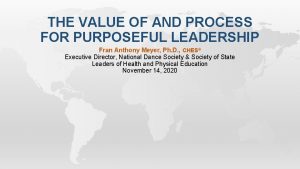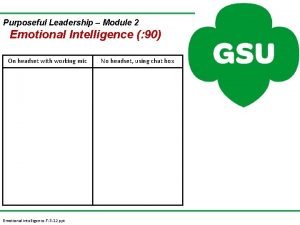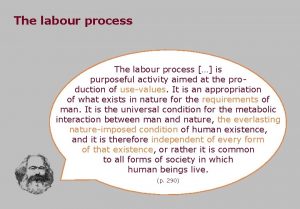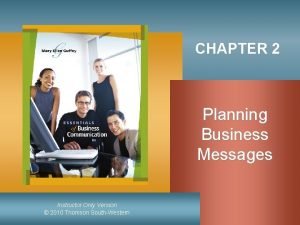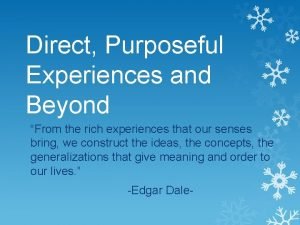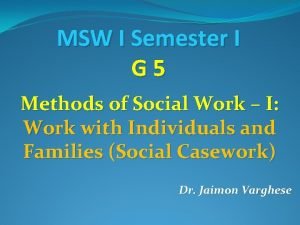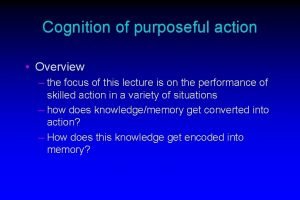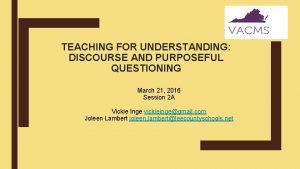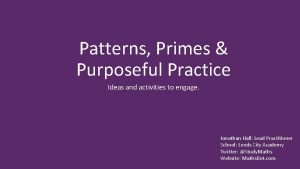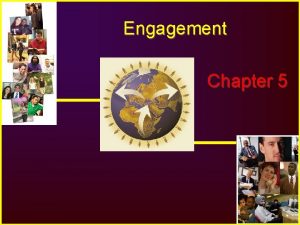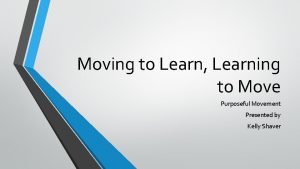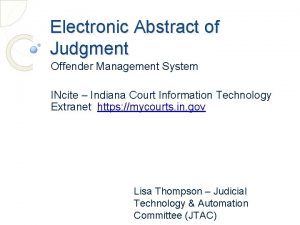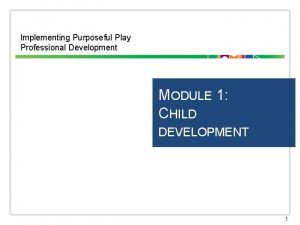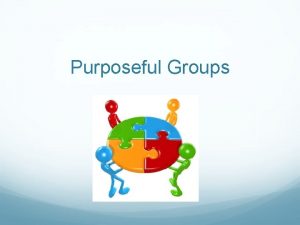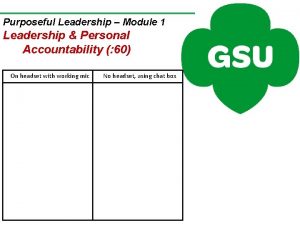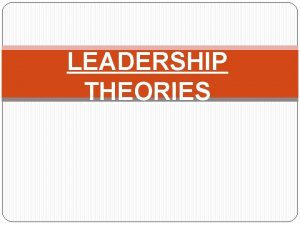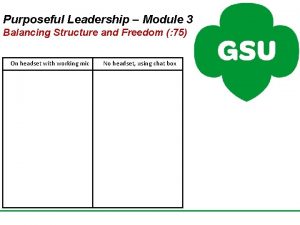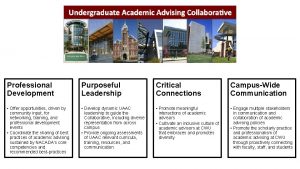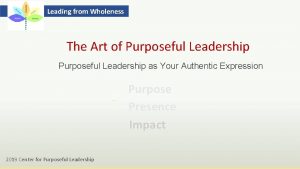THE VALUE OF AND PROCESS FOR PURPOSEFUL LEADERSHIP




















- Slides: 20

THE VALUE OF AND PROCESS FOR PURPOSEFUL LEADERSHIP Fran Anthony Meyer, Ph. D. , CHES® Executive Director, National Dance Society & Society of State Leaders of Health and Physical Education November 14, 2020

SESSION OBJECTIVES • Identify leadership characteristics and behaviors • Summarize findings of key authors’ research on leadership • Determine competencies and skills needed to build leadership among individuals and organization’s staff/members. • Explain a process of leadership learning among individuals and organization’s staff/membership • How to establish a process of leadership learning among an organization’s membership • competencies and skills needed to build leadership among an organization’s members

SETTING THE STAGE In the Chat Box: § Name two people you consider positive leaders. § Name characteristics or behaviors these individuals display. § Name two individuals who had a strong impact on you professionally. § Name characteristics or behaviors these individuals display. § Think about how the lists of characteristics and behaviors are similar or different.

CHARACTERISTICS OF ADMIRED LEADERS • Responsible/dependable • Accepts others’ viewpoints • Honest/Fair/Just • Confident • Organized/Efficient • Offers honest feedback tactfully • Sets realistic standards • Proactive/takes initiative • Strives for excellence • Consistent • Delegates responsibility • Persistent • Flexible • Committed/loyal • Good communicator/Listener • Recognizes others’ good works • Follower, too • Compassionate/caring • Accepting of others • Fun loving

POSITIVE LEADERSHIP BEHAVIORS • Innovate—look for new ways • Create excitement • Define goals well • Express pride in team • Articulate own values & beliefs • • Behave consistently with values Respect and appreciate ability • Promote & protect the team • Allow for failure • “Let it go” • Develop mutual trust • Create opportunities for success • Maintain positive & hopeful outlook • Enlist others in a common purpose -- Kouzes & Posner

HEARING FROM LEADER AUTHORS • As a leader, you have the power to influence, and you make a choice to either influence negatively or positively. -- Jeffery Gitomer • Think twice before you speak or [write]. Your words and influence will plant the seeds of either success or failure in the mind of another. -- Napoleon Hill • One of the hardest tasks of leadership is understanding that you are not what you are, but what you're perceived to be by others. " --Edward L. Flom, CEO of Florida Steel

HEARING FROM THE LEADER AUTHORS • Leadership is not about you. It’s about them and the way you make people feel. Make people feel like heroes—this will encourage them to do the right thing. -- Kouzes & Posner • As a leader, your every action has a consequence. Make sure it is the one you intended. -- Katherine Bryant • The measure of [persons] real character is what [they] would do if [they] knew [they] would never be found out. – unknown

QUESTIONING PERSONAL LEADERSHIP • What kind of leader am I? • What do you think people say about your leadership when you’re not around? • Am I a leader who would be on someone’s most admired leader list? • Am I a powerful force for positive change? Or, am I on some other list? • How am I at helping others achieve possibilities they didn’t even think possible? • How am I bringing out the best in others? • What needs to change?

CREATING EFFECTIVE LEADERSHIP Fundamental premises: • Leadership is a critical factor in the success or failure of tasks, projects, programs. • Emerging leaders need knowledge of established practices and effective tools. • Leaders should engage in critical thinking, problem solving, good communications, and collaboration. • Leaders empower others to action.

PURPOSEFUL LEADERSHIP With any leadership development program, the intent is to: • strengthen the quality & contributions of individuals to the field • enhance leadership skills & management practices, and • promote use of effective strategies

A VISION FOR A LEADER LEARNING PROCESS The current Leadership Academy of the National Dance Society envisions a dance community where professionals have the capacity to advance dance as a fine art, a basis for a well lifestyle, a support for academic success, and a forum for respecting a multicultural society, at any level chosen (community, state, national, or international).

THE APPLICATION • Demographic data • Personal background information & education • Professional background • Vision of the program for self • Self-assessment baseline • Recognizing & sharing honors

LEADERSHIP ASSESSMENT TOOLS • Di. SC Profiling Models Tools–multiple tools, situational assessments • Emotional Intelligence Assessment–knowing strengths & weaknesses • Enneagram–defines intersection of 9 personality types • Gallup Strengths Finder–focuses on strengths, not weaknesses • Myers-Briggs–determines personality types • USC’s Leadership Style Self-assessment–perception-based understanding of personality & unconscious biases • 360 Degree Feedback–use of multiple sources to obtain comments/opinions • Leadership Practices Inventory–also a 360 feedback tool

PRIMARY GUIDE TO EFFECTIVE LEADERSHIP IN ACTION • Mobilizing others to get extraordinary things done • 5 specific practices • 10 commitments for effective leadership • Transforming: • • • Values into actions, Visions into realities, Obstacles into innovations, Separateness into solidarity, and Risks into rewards Creating climates where people turn challenges into great successes

KOUZES &POSNER MAP PRACTICES TO COMMITMENTS 5 Practices Modeling the way 10 Commitments Find your voice by clarifying personal values Set example-align actions with shared values Inspire a shared vision Envision the future through exciting “dreams” Challenge the process Seek innovative ways to change, grow, and improve Enable others to act Foster collaboration, cooperative goals, & build trust Encourage the heart Recognize contributions; show appreciation for individuals Enlist others in a common vision; appeal to shared aspiration Experiment/take risks by generating small wins; learn from mistakes Strengthen others by sharing power & discretion Celebrate values & victories; create a spirit of community

DATA SHOW - LEADERS THAT USE THE FIVE FUNDAMENTAL PRACTICES: • are more effective in meeting job-related demands. • are more successful in representing others to upper management. • create high-performing teams. • foster renewed loyalty and commitment. • increase motivational levels and willingness to work hard. • extend the range of their agency’s services. • reduce absenteeism, turnover, and dropout rates. • possess high degrees of personal credibility.

LEADERSHIP ACADEMY LEARNING SESSIONS • Self-Assessment • Perception of others’ assessment of self • Experiential – Interactive • Reflection • Starts with fun and morphs into deep, soul-searching • Draw content from many sources/authors/theories • 18 -months – 2 -hours sessions/month • Outside learning experiences • Writing and scholarship

LEADERSHIP DEVELOPMENT AS SELF-DEVELOPMENT Leadership is an art—a performing art—and the instrument is the self. The mastery of the art of leadership comes with mastery of the self. Ultimately, leadership development is a process of self-development. Through self-development comes the confidence needed to lead. Selfconfidence is really awareness of and faith in your own powers. You should seek to learn as much as possible about the forces that affect the organization, be they political, economic, social, moral, or artistic. Leaders must be interpersonally competent. You must be able to listen, take advice, lose arguments, and follow, and you must be able to develop the trust and respect of others; otherwise, you can’t lead.

YOU TOO CAN MAKE A DIFFERENCE Always remember that leadership is a privilege. When you are in a leadership role, your influence may affect the trajectories of people’s entire careers (and, often, their lives!). …Unknown

THANK YOU FOR BEING A PURPOSEFUL LEADER IN IAHPEDS Questions? Fran Anthony Meyer, Ph. D. , CHES® Executive Director, National Dance Society & Society of State Leaders of Health and Physical Education IAHPEDSww@gmail. com 540 -412 -6343
 Purposeful leadership
Purposeful leadership Purposeful leadership
Purposeful leadership Studer rounding tool
Studer rounding tool Labour is a purposeful process of
Labour is a purposeful process of Contoh value creation
Contoh value creation Discriminative listening
Discriminative listening The best business writing is purposeful, economical, and
The best business writing is purposeful, economical, and What is purposeful listening
What is purposeful listening Direct and purposeful experiences
Direct and purposeful experiences Transformational leader and transactional leader
Transformational leader and transactional leader Value rational action example
Value rational action example 7 principles of social worker
7 principles of social worker Purposeful expression of feelings in social work
Purposeful expression of feelings in social work Purposeful action examples
Purposeful action examples Purposeful questioning
Purposeful questioning Purposeful listening
Purposeful listening Kaprekar's routine
Kaprekar's routine Purposeful expression of feelings
Purposeful expression of feelings What is purposeful movement
What is purposeful movement Jtac incite
Jtac incite Purposeful play definition
Purposeful play definition
